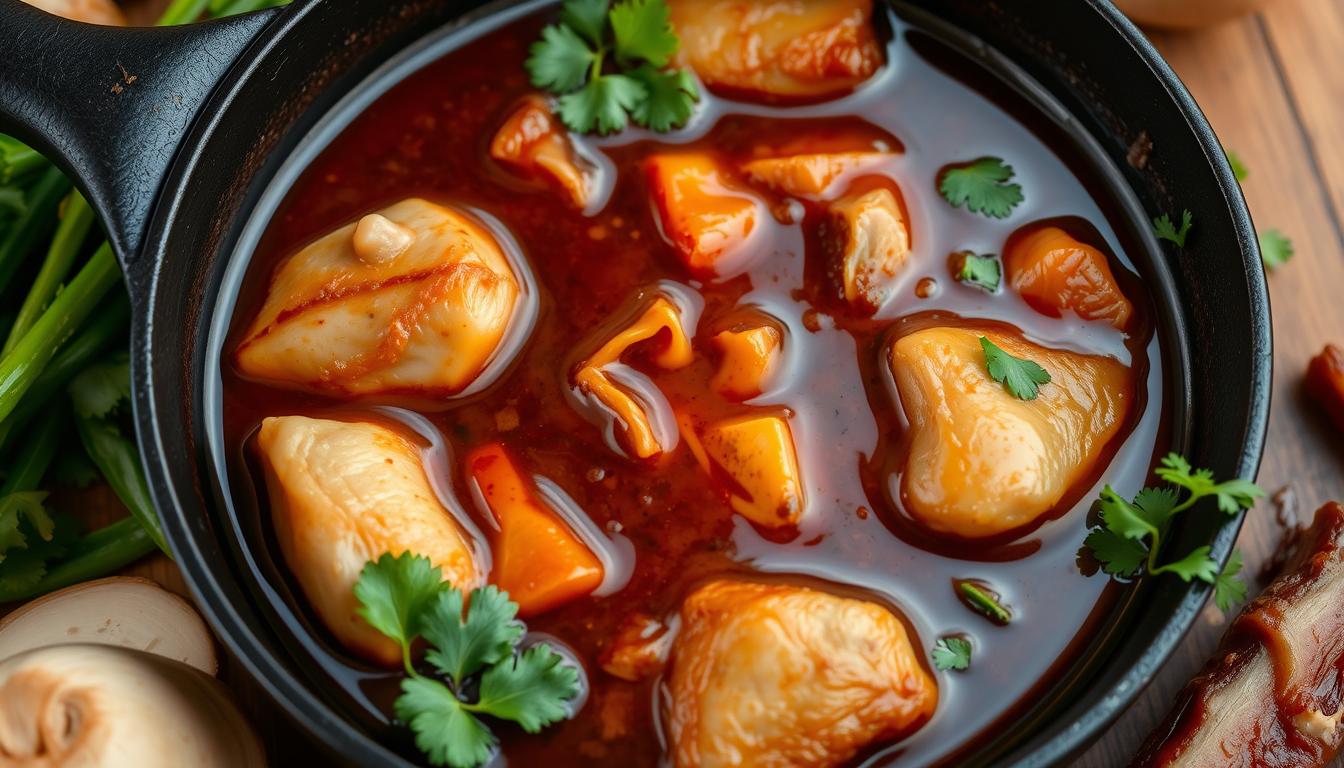Delicious Adobo Sauce Recipe: Bring Filipino Cuisine Home
Now you can enjoy the rich flavors of Filipino cuisine at home. This simple adobo sauce recipe is a key part of Filipino cooking. It combines unique ingredients that will make your meals special.
adobo sauce recipe teaches you how to make a traditional Filipino dish. It’s easy to prepare and can be used in many ways. Making your own adobo sauce lets you control the flavors and ingredients.
Table of Contents
Introduction to Adobo Sauce
This introduction will help you understand adobo sauce basics. You’ll learn about its history, cultural importance, and essential ingredients. With this knowledge, you can make your own delicious adobo sauce and enjoy Filipino flavors at home.
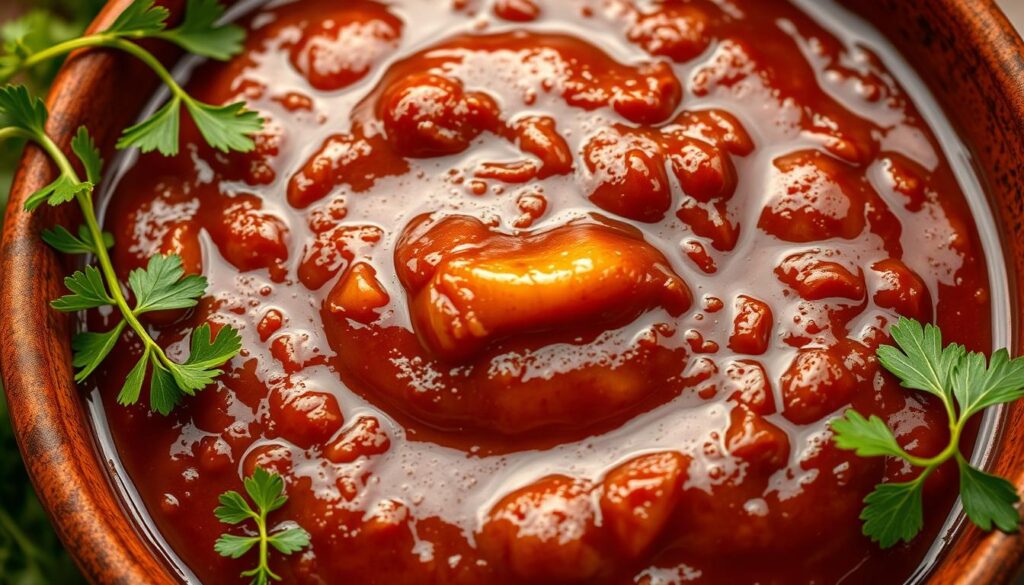
Key Takeaways
- You can make a delicious and authentic adobo sauce at home with this simple recipe.
- The adobo sauce recipe is a staple in Filipino cooking and is easy to prepare.
- This homemade adobo sauce is versatile and can be used in a variety of dishes.
- The authentic adobo sauce has a unique blend of ingredients that will elevate your meals.
- By following this adobo sauce recipe, you will be able to control the ingredients and adjust the flavors to your liking.
- This adobo sauce recipe is a great way to experience the rich flavors of Filipino cuisine in your own home.
- You will learn about the history and cultural significance of adobo sauce and how to make it at home.
Understanding the Rich History of Adobo Sauce
Exploring the easy adobo sauce recipe takes you back to its roots in the Philippines. It was first used as a marinade for meat and seafood. The Filipino version combines vinegar, soy sauce, garlic, and bay leaves for a unique taste.
The Mexican version of adobo sauce has its own twist. It uses chipotle peppers, oregano, and cumin for a smoky, spicy flavor. This version is a key ingredient in many Mexican dishes, like tacos and grilled meats.
Origins and Influences
- Filipino adobo sauce originated in the Philippines, influenced by Spanish and Chinese cuisine.
- Mexican adobo sauce was inspired by the Filipino version but uses local ingredients.
- Both versions are crucial in their cuisines, used in many dishes.
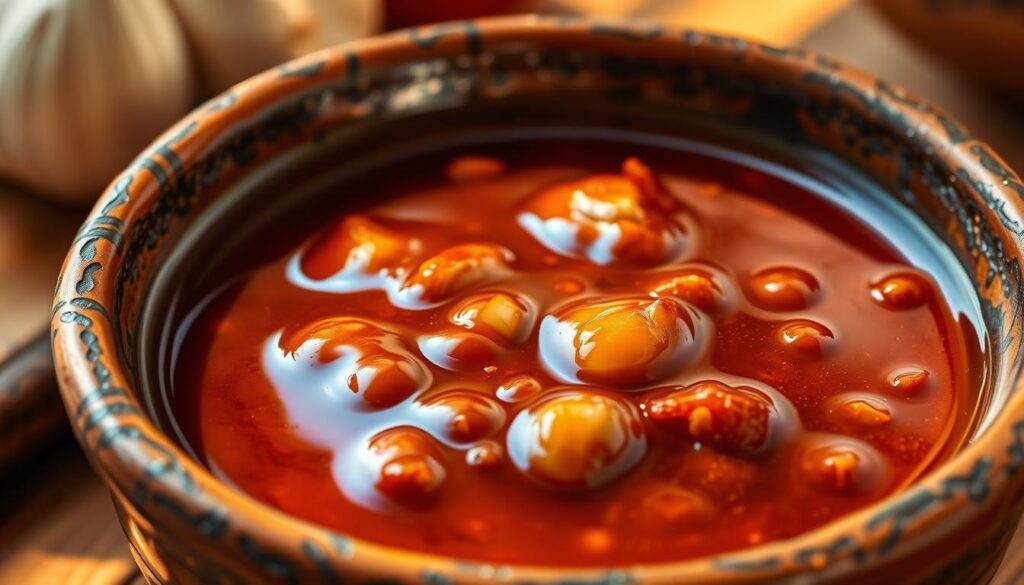
Knowing the history and cultural importance of adobo sauce enriches your appreciation for it. Whether you’re making an easy adobo sauce recipe or trying different versions, the secret is balancing flavors and ingredients. Adobo sauce’s rich history and versatility make it a must-have in your kitchen, adding flavor to your favorite dishes.
Essential Ingredients for the Perfect Adobo Sauce Recipe
To make the perfect adobo sauce, you need to know the adobo sauce ingredients that make it so tasty. The main parts are vinegar, soy sauce, garlic, and bay leaves. These add the rich, tangy taste we love in adobo sauce. For a spicy adobo sauce, add chili peppers or hot sauce for more heat.
Here are the main ingredients you’ll need:
- Vinegar
- Soy sauce
- Garlic
- Bay leaves
- Chili peppers or hot sauce (for spicy adobo sauce recipe)
These ingredients will help you make a delicious, authentic adobo sauce. It’s great for many dishes. By mixing the right adobo sauce ingredients, you can make a sauce that’s both tasty and spicy adobo sauce for those who like it hot.

Remember, the secret to a great adobo sauce is using top-notch ingredients and getting the flavors just right. With these key ingredients and a bit of practice, you’ll be whipping up amazing adobo sauce in no time.
Traditional Filipino Adobo Sauce vs Mexican Adobo: Key Differences
Exploring adobo sauce recipe reveals two main types: Filipino and Mexican. Each has its own taste, ingredients, and cooking ways. To make a true authentic adobo sauce, you must pick the right method for your taste.
Understanding the ingredients is key to making homemade adobo sauce. Filipino sauce often has vinegar, soy sauce, garlic, and bay leaves. Mexican adobo, on the other hand, includes chipotle peppers, garlic, and oregano. These ingredients greatly change the sauce’s taste.

Flavor Profile Comparison
- Filipino adobo sauce has a sour and savory flavor
- Mexican adobo sauce has a smoky and slightly sweet flavor
Knowing these differences lets you make a tasty authentic adobo sauce that you’ll love. Whether you’re making it from scratch or using a store-bought adobo sauce recipe, knowing the traditional ways and ingredients is crucial for the best taste.
Step-by-Step Authentic Adobo Sauce Preparation
To make authentic adobo sauce, follow a simple process. Learning how to make adobo sauce boosts your cooking skills. It also lets you explore Filipino cuisine’s flavors. Start by mixing vinegar, soy sauce, garlic, and bay leaves in a saucepan.
Then, add your favorite protein like chicken or pork. Simmer until the meat is fully cooked. This easy adobo sauce recipe adds flavor to your meals quickly. As you cook, the sauce thickens, and the flavors blend, making a rich adobo sauce.
Here are the basic steps to follow:
- Combine ingredients in a saucepan
- Add protein and simmer until cooked
- Let the sauce thicken and the flavors meld together
By following these steps and using quality ingredients, you’ll make a delicious adobo sauce. It’s great with rice, veggies, or as a marinade. Remember, fresh and flavorful ingredients are key. Experiment to find the best combination for you.
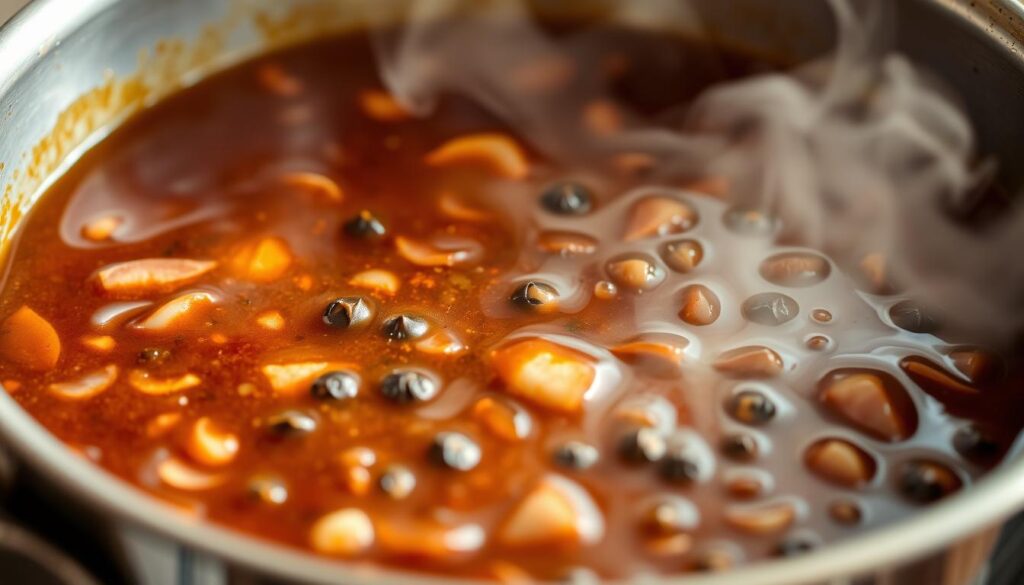
Master Tips for Creating the Best Homemade Adobo Sauce
To make the best homemade adobo sauce, knowing the right ingredients is key. When you’re making your own adobo sauce, keep these tips in mind. They’ll help you get the perfect mix of flavors.
Getting the ingredient ratio right is important. A good mix includes vinegar, soy sauce, garlic, and bay leaves. You can tweak the amounts to match your taste. For a richer flavor, choose top-notch ingredients and don’t simplify the recipe too much.
Here are some common mistakes to avoid when making your homemade adobo sauce:
- Using low-quality ingredients
- Not adjusting the seasoning to taste
- Overcooking the sauce, which can lead to a bitter taste
It’s also crucial to store and preserve your sauce well. Keep it in an airtight container in the fridge. This way, it stays fresh and flavorful for longer.
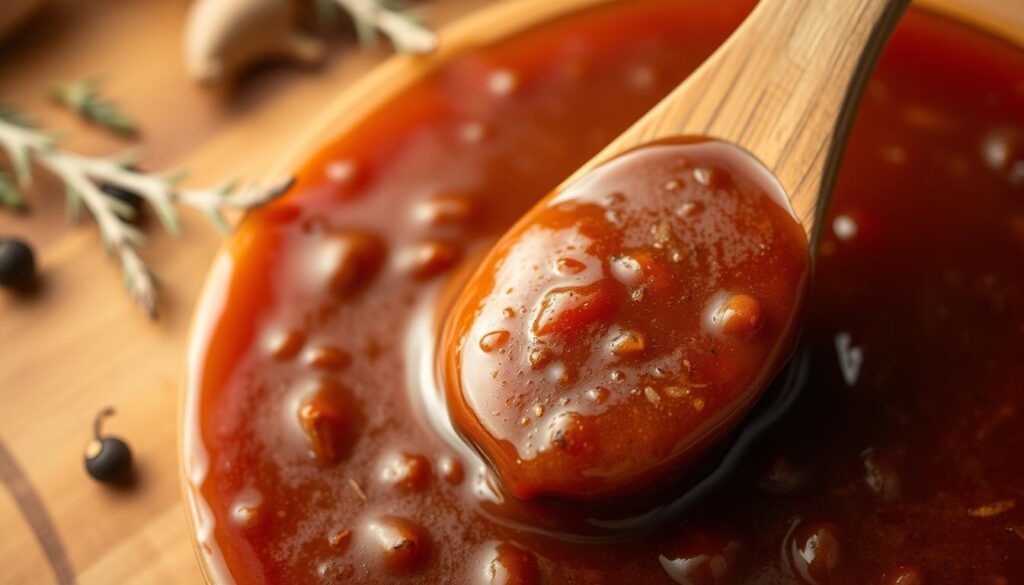
By following these tips and using the best ingredients, you can make a delicious homemade adobo sauce. It will take your dishes to a whole new level.
Versatile Ways to Use Your Adobo Sauce
Now that you know how to make delicious adobo sauce, it’s time to explore its uses. You can use it in marinades, sauces, dips, and spreads. It adds flavor and depth to any meal. You can also use it to create new recipes.
Adobo sauce is very versatile, and you can make many variations. Use it as a marinade for grilled meats, a sauce for stir-fries, or a dip for veggies. You can mix different ingredients and flavors to make your own unique sauce.
Some popular ways to use adobo sauce include:
- Marinades for chicken, beef, and pork
- Sauces for stir-fries and noodle dishes
- Dips for vegetables and chips
- Ingredients for soups and stews

Adobo sauce adds a rich and savory flavor to any meal. It’s great for adding excitement to your dinner routine or impressing guests with a new recipe. So, get creative and try out different adobo sauce variations.
Spicing Up Your Adobo: Heat Level Variations
The heat level in adobo sauce can change how much you enjoy it. You can make it mild for the family or spicy for a bold taste. Understanding how chili peppers, garlic, and vinegar work together is key to getting the right flavor.
Spicy adobo sauce brings a rich and complex taste to your meals. To make it spicy, add diced jalapenos or serrano peppers. For a milder taste, use less chili pepper or none at all.
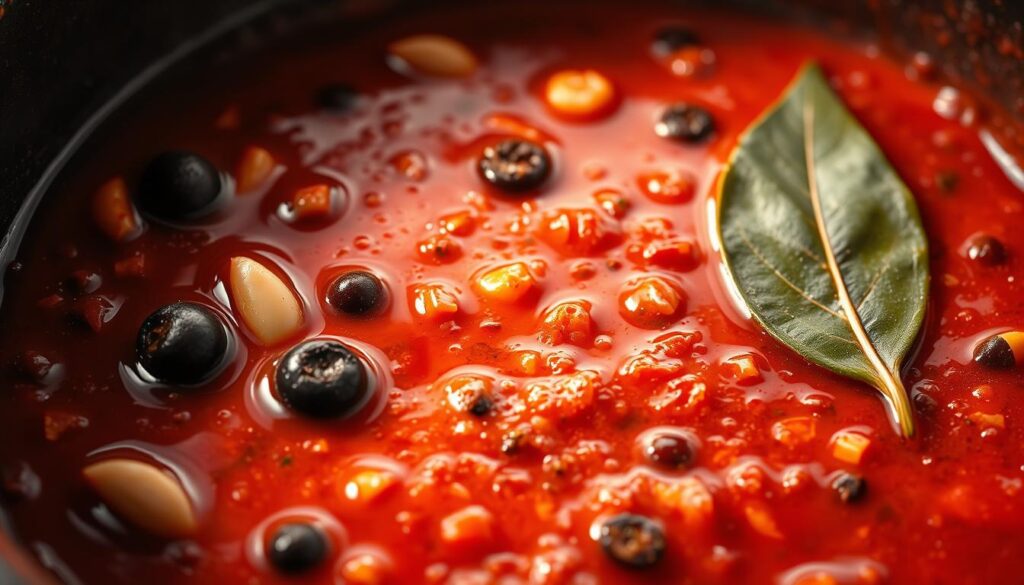
- For a mild and family-friendly option, use just a small amount of chili pepper or omit it altogether.
- For a medium heat level, add a moderate amount of chili pepper, such as a diced jalapeno or serrano pepper.
- For a fiery hot variation, use a large amount of chili pepper or add in other spicy ingredients, such as diced habaneros or ghost peppers.
By trying out different heat levels and ingredients, you can make an adobo sauce that suits your taste. Whether you prefer it spicy or mild, the secret to a great adobo sauce is finding the right balance of flavors and heat.
Dietary Modifications and Substitutions
When making adobo sauce, you can adjust the ingredients to fit your diet. If you’re vegetarian, vegan, or gluten-free, there are many choices. You can use adobo sauce ingredients like garlic, vinegar, and soy sauce, which are naturally gluten-free. This makes a tasty and safe sauce for those with gluten intolerance.
To make a vegetarian or vegan adobo sauce, swap out the meat with plant-based options. Mushrooms, tofu, or tempeh can add protein and texture. These changes let you enjoy the rich taste of homemade adobo sauce while sticking to your diet.
Here are some other ways to modify your adobo sauce:
- Use gluten-free soy sauce or tamari.
- Replace chicken or beef broth with vegetable broth.
- Add different spices and seasonings to boost the flavor.
With a bit of creativity and experimentation, you can make a delicious, customized adobo sauce. It will match your taste and dietary needs perfectly. Enjoy the rich flavor of adobo sauce ingredients in a way that’s just right for you.

Pairing Your Adobo Sauce with Different Proteins
Adobo sauce is incredibly versatile. You can use it as a marinade, sauce, or seasoning. It adds flavor and moisture to many proteins. Let’s look at how you can pair it with chicken, pork, seafood, and even vegetarian options.
Chicken and pork are popular choices for adobo sauce. Marinate them in a mix of adobo sauce, vinegar, and spices. Then, grill or cook them until they’re perfect. The sauce’s mix of soy sauce, vinegar, garlic, and bay leaves creates a rich taste.
To make the sauce, combine these ingredients with oil and spices. Simmer them to get a thick, flavorful sauce.
Seafood fans can enjoy adobo sauce with shrimp, fish, or squid. Just marinate the seafood in adobo sauce, lemon juice, and spices. Then, grill or sauté it. Vegetarians can use adobo sauce on tofu or tempeh. Here are some ideas for pairing adobo sauce with different proteins:
- Chicken: marinate in adobo sauce, vinegar, and spices, then grill or cook
- Pork: marinate in adobo sauce, vinegar, and spices, then grill or cook
- Seafood: marinate in adobo sauce, lemon juice, and spices, then grill or sauté
- Vegetarian: use adobo sauce as a seasoning for tofu or tempeh

Try different proteins and adobo sauce recipes to make tasty dishes. Adobo sauce works well with chicken, pork, seafood, and vegetarian options. It adds flavor and moisture to any dish.
Troubleshooting Your Adobo Sauce
When making homemade adobo sauce, you might face some common problems. These can affect the sauce’s taste and texture. To get it just right, it’s key to know how to fix these issues.
One common problem is when the oil and vinegar separate. This can be fixed by whisking the sauce well before using it.
Another issue is when spices and herbs settle at the bottom. To avoid this, strain the sauce through a fine-mesh sieve before storing it. If the sauce tastes too salty or sour, you can fix this by adding a bit of authentic adobo sauce.
Choosing high-quality ingredients is vital for a great homemade adobo sauce. Fresh herbs and spices make the sauce taste better. Using low-quality ingredients can make it taste dull. Plus, making it from scratch lets you control the salt and sugar, making it healthier.
- Whisk the sauce thoroughly before using it to prevent separation
- Strain the sauce through a fine-mesh sieve to prevent sedimentation
- Adjust the flavor by adding a small amount of authentic adobo sauce
- Use high-quality ingredients to ensure a vibrant flavor
By following these tips, you can make a delicious homemade adobo sauce. Always taste and adjust as you go. Don’t be afraid to try new ingredients and flavors to make your own unique adobo sauce.
Conclusion: Mastering the Art of Adobo Sauce at Home
Creating an authentic adobo sauce recipe at home is rewarding and flavorful. You now know the rich history and cultural significance of this beloved Filipino dish. This knowledge lets you make your own delicious homemade adobo sauce to enhance your meals.
The secret to mastering adobo sauce is its versatility. You can adjust the heat level to your liking, from mild to fiery. Adobo sauce also fits various dietary needs, making it perfect for everyone.
With the guide’s step-by-step instructions and expert tips, you can make authentic flavors at home. Try different proteins, vegetables, and sides to explore authentic adobo sauce‘s endless possibilities. Your home-cooked meals will impress everyone, thanks to your adobo sauce skills.
FAQ
What is Adobo sauce?
Adobo sauce is a tasty, tangy sauce from Filipino cuisine. It’s made with vinegar, soy sauce, garlic, and spices. This mix creates a rich sauce for many dishes.
What are the key ingredients in Adobo sauce?
Key ingredients are vinegar, soy sauce, garlic, bay leaves, and black pepper. Onions, chili peppers, and herbs are also common.
What is the difference between Filipino Adobo and Mexican Adobo?
Filipino Adobo is tangy and savory. Mexican Adobo is smoky, spicy, and sometimes sweet. They differ in taste and cooking style.
How do I make authentic Adobo sauce from scratch?
Mix vinegar, soy sauce, garlic, bay leaves, and black pepper. Simmer them together to blend the flavors for that unique Adobo taste.
Can I adjust the heat level of my Adobo sauce?
Yes, adjust the heat by adding more chili peppers or hot sauce. For less heat, use fewer or no chili peppers. For more heat, add more or use hotter peppers.
How can I use Adobo sauce in my cooking?
Adobo sauce is great as a marinade, sauce, or seasoning. It’s good for chicken, pork, beef, and seafood. It’s also great as a dipping sauce or in rice dishes and stir-fries.
Can I make Adobo sauce ahead of time and store it?
Yes, you can make it ahead and store it in the fridge for a week or freeze it for months. It’s handy for quick meals or meal prep.
Are there any dietary modifications or substitutions for Adobo sauce?
Yes, you can modify Adobo sauce for different diets. Use vegetable broth for a vegetarian or vegan version. Replace soy sauce with gluten-free options for gluten-free diets.

